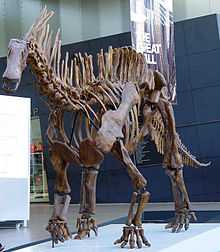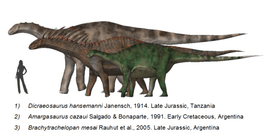Dicraeosauridae
| Dicraeosauridae Temporal range: Late Jurassic - Early Cretaceous | |
|---|---|
 | |
| Amargasaurus | |
| Scientific classification | |
| Kingdom: | Animalia |
| Phylum: | Chordata |
| Superorder: | Dinosauria |
| Suborder: | Sauropodomorpha |
| Superfamily: | Diplodocoidea |
| Family: | Dicraeosauridae Janensch, 1929 |
| Genera | |
Dicraeosauridae is a family of sauropod dinosaurs known from the Late Jurassic and Early Cretaceous of Africa and South America. Currently only three genera are recognised; the Jurassic South American genus Brachytrachelopan, the Jurassic African Dicraeosaurus and the South American Early Cretaceous Amargasaurus, with its distinctive neck spines. All three animals are small by sauropod standards, with relatively short necks.

McIntosh (1990) includes a number of genera within the subfamily Dicraeasaurinae of the family Diplodocidae, but many of these are now recognised as belonging to distinct families (Nemegtosauridae and Rebbachisauridae).
The group is described cladistically as a stem-based taxon defined as "The most inclusive clade containing Dicraeosaurus hansemanni Janensch 1914 but not Diplodocus longus Marsh 1878" or as "all diplodocoids more closely related to Dicraeosaurus hansemanni than to Diplodocus longus (Sereno 1998 p.63, Upchurch et al. 2004 p.304, Wilson 2005 p.35)

Sources
- Sereno (2005). edit.php?tax_id=107&Action=View Taxon Search : Dicraeosauridae
- McIntosh, J. S. (1990). "Sauropoda" in The Dinosauria, Edited by David B. Weishampel, Peter Dodson, and Halszka Osmólska. University of California Press, pp. 345–401.
- Upchurch, P., Barrett, P.M. and Dodson, P. (2004). Sauropoda. In The Dinosauria, 2nd edition. Weishampel, Dodson, and Osmólska (eds.). University of California Press, Berkeley. pp. 259–322.
- Sereno, P. (1998). A rationale for phylogenetic definitions, with application to the higher-level taxonomy of Dinosauria. Neues Jahrbuch für Geologie und Paläontologie 210: 41-83.
- Wilson, J.A. (2002). Sauropod dinosaur phylogeny: critique and cladistic analysis, Zoological Journal of the Linnean Society 136(2):215-275
- ------ (2005) "Overview of Sauropod Phylogeny and Evolution", in Curry Rogers and Wilson, eds, 2005, The Sauropods: Evolution and Paleobiology, University of California Press, Berkeley, ISBN 0-520-24623-3